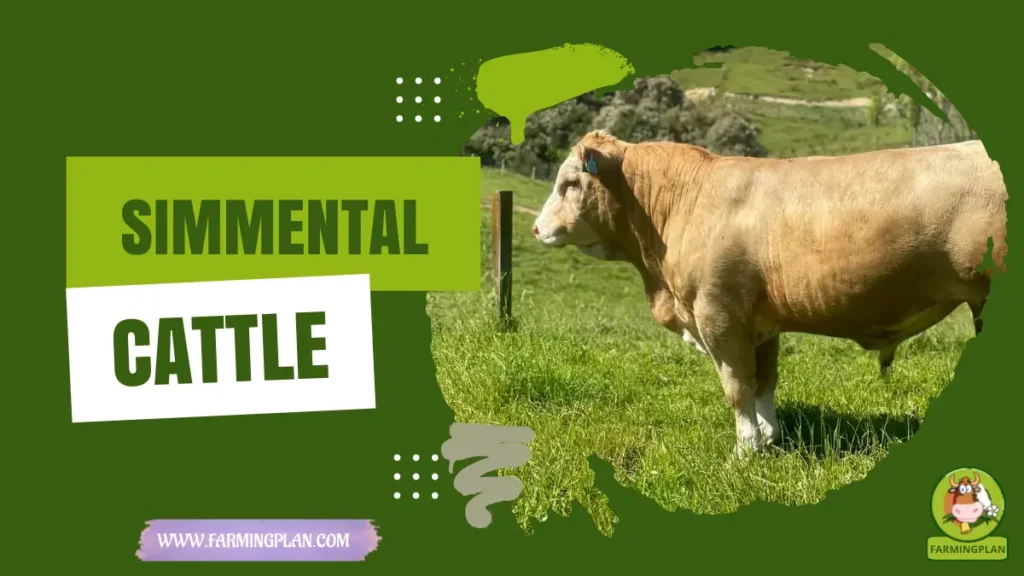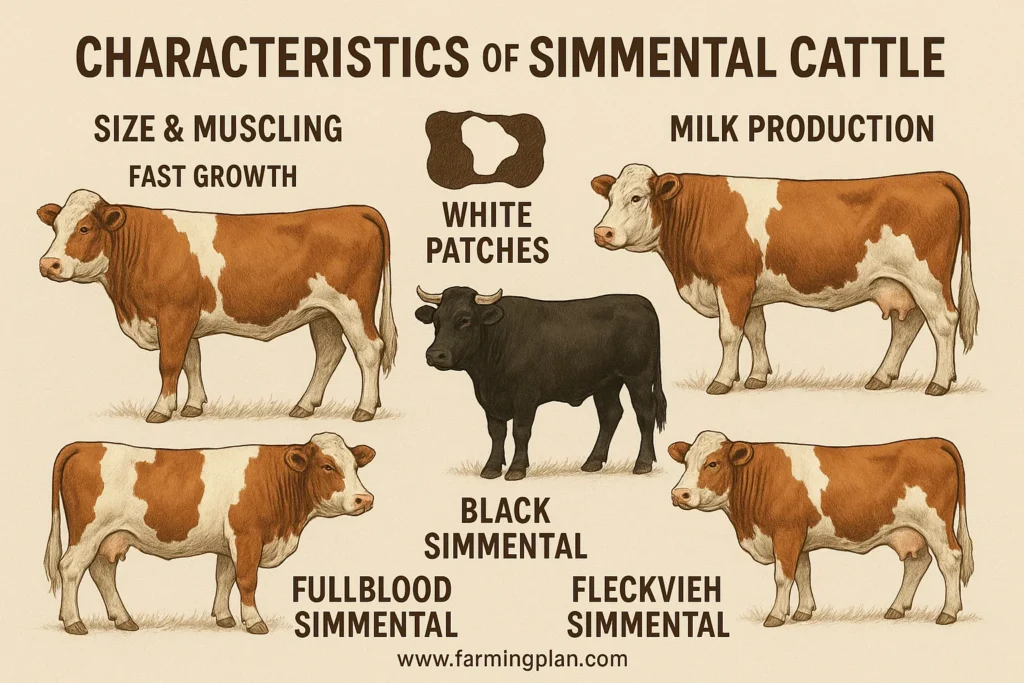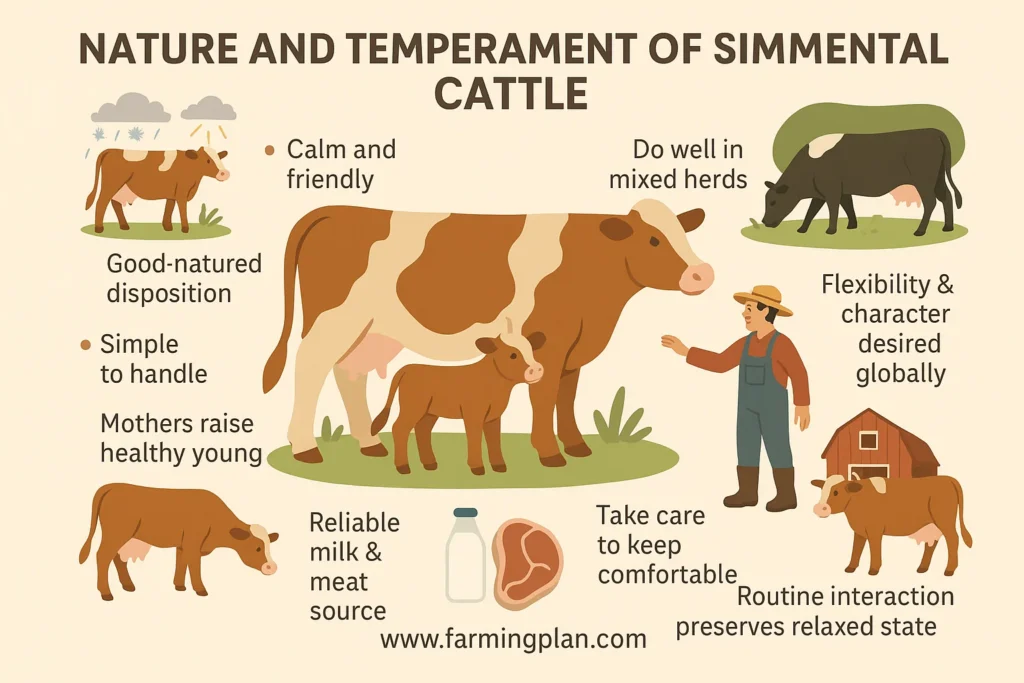Simmental cattle are one of the most admired breeds worldwide, known for their impressive growth, excellent milk yield, and versatile use in both beef and dairy farming. This adaptable breed includes popular varieties like red Simmental cattle and black Simmental bulls, making them a favorite among breeders and farmers. Whether you’re interested in beef Simmental for meat production or the dairy qualities of the breed, understanding Simmental cattle’s traits and history can help you make the best choices for your farm or herd. In this article, we’ll explore everything you need to know about Simmental cattle, from their origin to care tips, so you can raise healthy, productive animals.

History & Origin of Simmental Cattle
The breed traces its beginnings to the captivating countryside and fertile lands of the Simme Valley in Switzerland, where it can be traced for hundreds of years. This breed has traveled through many European regions and has been shaped by crosses with some of the continent’s dairy breeds.

By the late 1960s, the breed had found its way to various countries through organized breeding programs and related organizations. Acknowledgment by the Swiss Parliament of the breed’s dairy prowess and good growth rate only enhanced its international spread. Breeders such as Travers Smith helped raise the profile of Simmental cattle, making them a top choice for both beef and dairy farmers.
Read More: Pinzgauer Cattle: Milk & Meat Excellence
Characteristics of Simmental Cattle
These cattle stand out for their impressive size and strong build. They come in several colors, including the well-known red Simmental cattle, black Simmental bulls, and white patches that make them easily recognizable. This breed grows rapidly, with calves showing superb weight gain early on.

Simmental cattle also have excellent milk production, which makes them a top choice for both beef and dairy farmers. Their strong mothering ability and adaptability add to their appeal. Varieties like Fullblood Simmental and Fleckvieh Simmental show how diverse the breed is, but all share traits like fast growth and high milk yield.
Read More: Shorthorn Cattle: The Perfect Dual-Purpose Breed for Farmers
Nature and Temperament of Simmental Cattle
These calms and friendly cattle are simple to handle by experienced farmers and livestock producers of any size. These cattle are able to weather various weather conditions and when kept in a variety of farming environments. The mothers in the Simmental breed are remarkable at raising their young to be healthy and robust.

Their good-natured disposition allows them to do well in mixed herds and provides a good, reliable source of milk and meat for the farmer. Their flexibility and character are primary factors that keep Simmental cattle desired globally. Care must be taken to keep Simmental cattle comfortable since they react to sudden changes easily. Routine interaction with humans and other animals preserves their relaxed disposition.
Read More: White Park Cattle: A Treasure for Farmers
Food & Diet for Simmental Cattle
Feeding Simmental cattle the right diet is not just a task, it’s a key responsibility that directly impacts their rapid growth and excellent milk production. These animals thrive on a balanced mix of fresh pasture, quality hay, and grains rich in energy and protein. For beef Simmental, a diet focused on higher energy helps maximize weight gain, while dairy-focused Simmentals need nutrients that support milk yield. Avoid sudden changes in feed and provide plenty of clean water every day. This commitment to proper nutrition not only boosts growth rates but also supports the overall health and mothering ability of the herd.
Usage and Purpose of Simmental Cattle
Simmental cattle are amazingly versatile on farms, so they’re considered really valuable. Their ability to produce both high-quality beef and a good milk supply makes them truly valuable. Simmental bulls are selected by farmers for breeding due to their rapid growth and outstanding carcass quality. Due to their great muscular power and endurance, Simmental cattle are sometimes used as working farm animals in certain agricultural areas. Simmental genetics are frequently incorporated into crossbreeding programs to improve the growth, milk yield, and ease of adaptation in different cattle breeds. Their adaptability provides a host of options for farmers, making Simmental cattle highly desirable.
Special Features of Simmental Cattle
Simmentals are renowned for possessing qualities that distinguishes them from other cattle breeds. they’ve the ability to withstand insects better than many other breeds, preventing problems for both animals and their caretakers. As a result of heterosis, Simmental cattle produce calves when crossed with another breed that tend to exhibit greater growth and health compared to full-blood calves.
They gain recognition for their excellent carcass quality from performance test results carried out by select breeders. The ability to raise fast, produce plentiful milk and adapt to almost any environment earns them international acclaim as a valuable and highly desired breed. Simmental cattle also have exceptionally high fertility levels that help ensure a successful herd. they’re widely chosen by farmers because of their ability to thrive in different climates and farming systems.
Health Issues & Prevention in Simmental Cattle
Simmental cattle are generally hardy, but they can face common cattle diseases like respiratory infections and parasites. Farmers should watch for symptoms such as coughing, loss of appetite, or unusual behavior. Regular vaccinations and parasite control keep herds healthy. Breeders maintain detailed dam records and monitor performance data to catch health issues early. Preventive care, including clean housing and good nutrition, plays a big role in reducing risks and ensuring your Simmental cattle stay strong and productive.
Step-by-Step Farming Guide for Simmental Cattle
Prepare Your Farm: Set up sturdy fencing and provide shelter with good ventilation to protect your Simmental cattle from harsh weather.
Choose Quality Animals: Start with registered Simmental bulls and cows from trusted breeders like JS Simmentals or KSL Simmentals to ensure purebred stock.
Feeding Schedule: Offer a balanced diet of fresh pasture, hay, and grains tailored for growth or milk production. Provide clean water at all times.
Daily Care: Check cattle health daily, looking for signs of illness. Maintain clean bedding and a safe environment.
Breeding Management: Use performance data and selective breeding to improve your herd’s growth rate and milk yield. Keep detailed records for each animal.
Calf Care: Monitor calves closely during their first months for proper growth and health. Ensure they get colostrum shortly after birth.
Health Maintenance: Vaccinate regularly and use parasite control measures. Consult a vet if you notice any health issues.
Expert Tips & Best Practices for Raising Simmental Cattle
Emphasize strategic breeding to improve your cattle’s growth rate, milk yield and general well-being. Reliable breed association resources provide current information about genetic progress and breeding developments. Grafting data from Simmental sires can help your herd develop faster-growing, more nurturing cows. Record all herd information carefully for progress monitoring. A nutritious diet and proper management play vital roles in keeping your cattle healthy and productive.
Regularly review your herd’s growth and milk records to identify top performers for breeding and culling.
Where to Buy Simmental Cattle
Finding quality Simmental cattle for sale means choosing trusted breeders and associations. Well-known sources like JS Simmentals and KSL Simmentals offer registered animals, including red Simmental bulls for sale and black Simmental bulls. Look for breeders who provide complete pedigree and performance records to ensure purebred stock. Breed associations such as the American Simmental Association and the European Simmental Federation maintain herdbooks that help buyers verify authenticity. When buying, inspect animals carefully and ask for health and growth records to make the best choice for your herd.
FAQ
What makes Simmental cattle unique compared to other breeds?
Simmental cattle stand out because of their fast growth, impressive milk yield and ability to thrive in a wide range of environments. they’re a breed that can deliver both meat and milk to the highest standards.
How fast do Simmental calves grow?
Simmental calves exhibit a rapid growth rate, gaining weight quickly due to their strong genetics and efficient feed conversion. This makes them popular among beef producers.
Are Simmental cattle better for dairy or beef production?
Simmental cattle are versatile and excel in both dairy and beef production. Many farmers appreciate their ability to provide high milk yields while also producing quality beef.
Where can I buy registered Simmental bulls?
You can buy registered Simmental bulls from reputable breeders such as JS Simmentals and KSL Simmentals, or through breed associations like the American Simmental Association, which maintain verified herdbooks.
What are common health issues in Simmental cattle?
Common health issues include respiratory infections and parasites, but with proper vaccinations, parasite control, and good nutrition, these cattle remain generally hardy and healthy.
Conclusion
Known for early maturity, high-quality milk production and suitability for both beef and dairy, Simmental cattle have gained recognition around the world. They first appeared in Switzerland’s Simme Valley and have since become known worldwide through intensive breeding efforts by various national and international organizations. Their friendly nature, natural insect defenses and outstanding motherhood qualities recommend them as outstanding choices for any farm or breeding program. Adequate nutrition, good veterinary care and precision breeding help maximize Simmental cattle’s performance. Simmental cattle excel in both breeding and production for today’s progressive agriculture.

